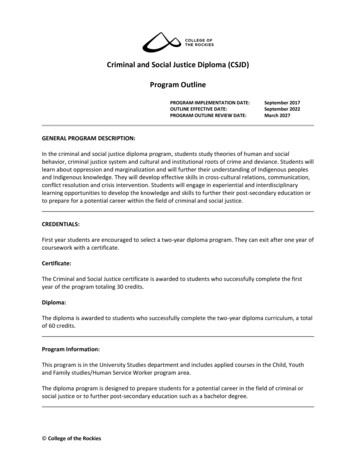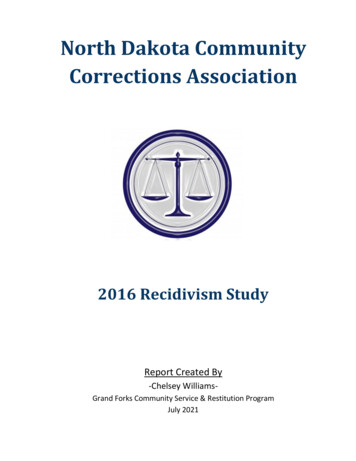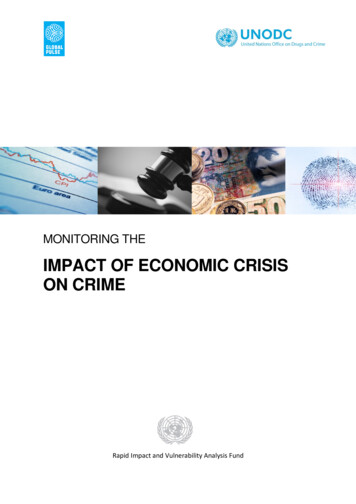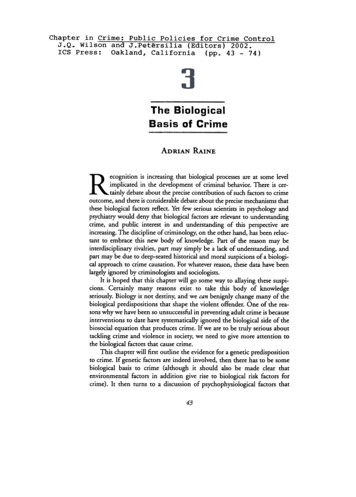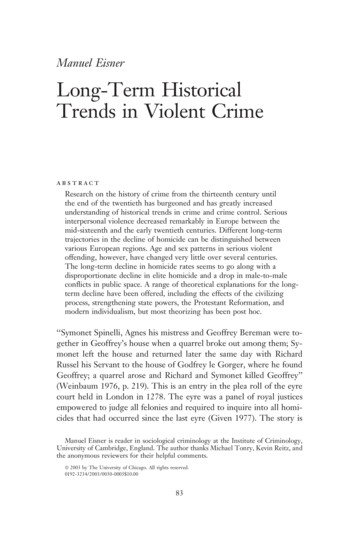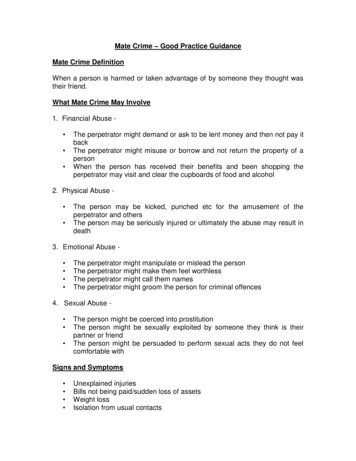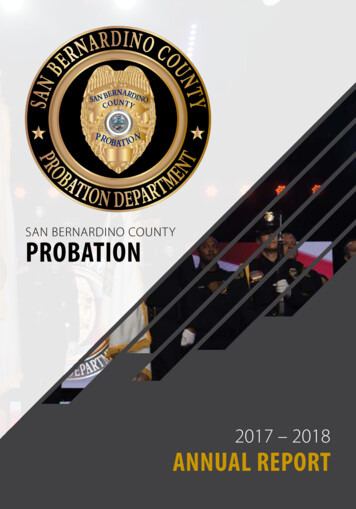
Transcription
West Baton Rouge Parish Health ProfileSAFETY &CRIMESAFETY ILITATIONIn 1997, the U.S. incarcerated a greater proportion of itspopulation than any countries except Russia. More than 1.7million people were either in prison or in jail in 1997, reflectingan incarceration rate of more than 645 per 100,000 residents,double the rate of a decade before. Approximately one in every117 adult males was in prison. Human Rights Watch, 1999Contributors to thischapter include:Louisiana Departmentof Safety andCorrections,Information Office225-342-8782
180 West Baton Rouge Parish Health ProfileSAFETY &PP CORRECTIONSHow is this parishdoing?Crimein LouisianaLCrimein the parishLCommunitypolicingKCRIME AND SAFETYEvery night on the news, crime is a sobering reality. Crime is a scary topic for manycommunities. Sometimes the fear of crime may be bigger than are the real risks. Thisis especially true for violent crimes. A desire for personal safety can affect howpeople feel and where they live. It can also affect choices about work and play time.Violence and crime are related to other factors which affect health. Low educationallevels, poverty, unemployment and discrimination are all risk factors for violence andpoor health. According to the DHHS, violence and the perception of violence, bothhave a great impact on quality of life (U.S. Department of Health and HumanServices, 1998).Another way crime and safety issues can impact health is by creating a perception thatindividuals can not trust people in their neighborhoods or communities. Recently, astudy showed a correlation between a lack of trust and a self-report of poor health.DID YOU KNOW?People who reported a distrust of the people around them also reported being in poorThe cost of crime tohealth. The greater the mistrust, the more likely they were to say they have bad healthvictims is an estimated 450 billion per year(Kawachi et al, 1999). In 1999, thewhen factors such asCenters for Disease Control andmedical cost, lost . . . in 1998earnings, pain, suffering Prevention reported that the perception ofdanger in a neighborhood had a negativeand lost quality of lifeLouisiana had theare considered.impactonresidents abilitytogetregular-- Miller, 1996.nation s highest ratephysical activity, an important part ofoverall health (Centers for Diseaseof residents put inControl and Prevention, 1999).The remainder of this chapter looks atcrime and safety from a more traditionalperspective. It includes a discussion ofincarceration rates, admissions in theparish and state, community policing andrehabilitation efforts.prison. This statisticis called anincarceration rate. According to the U.S. Bureau of Justice Statistics, in 1998 Louisiana had the nation shighest rate of residents put in prison (Butterfield, 1999). This statistic is called anincarceration rate. The incarceration rate is based upon the number of state or federalprisoners with sentences of more than one year per 100,000 residents. The yearbefore, in 1997, Louisiana had 651 prisoners per 100,000 residents. OnlyTexas had a higher rate of 677 per 100,000 residents. The U.S. rate in 1997 was436 per 100,000 residents.In 1998, Louisiana s rate rose to 709 per 100,000. Louisiana s rate is 44percent higher than the U.S. total incarceration rate of 506 per 100,000(Butterfield, 1999 and [1] Louisiana Department of Public Safety and Corrections,1998). An increased incarceration rate does not necessarily mean that crime isgrowing. Rather, it could mean that the process of arrest, prosecution and sentencinghas changed to produce more prison sentences.
181West Baton Rouge Parish Health ProfileSAFETY &CORRECTIONSPPFigure 1:Weapons used in Crimes, Louisiana, 1997Firearms100%KnivesPercent of crimes78%Other80%Personal63%DID YOU KNOW?Nationally, one violentcrime occurred every 19seconds in 1997.60%40%33%29% 26%20%20%National Center for Victims ofCrime, 1998.18%5% 6%10%8%4%0%Aggravated AssaultRobberiesMurdersSource: Federal Bureau of Investigation, 1998.In Louisiana, one out ofevery two peoplereleased from prison willreturn within four years.-(2) Louisiana Department ofPublic Safety and Corrections,1998.The Department of Public Safety and Corrections (DPSC) in Louisiana, as well asfederal agencies such as the Bureau of Justice and the Federal Bureau ofInvestigation, collect information on how many and what types of crimes arecommitted. These agencies also record information about people in prison, on paroleor on probation. This information helps agencies plan for a prison population of acertain size, as well as address policy. The information also helps the public andlawmakers see the effect laws and law enforcement have on safety and crime.This section presents the following indicators:lWeapons used in crimes;lMethods of homicide; andlThe types of crimes committed by parishCommunity policing and drug courts play aprominent role in this chapter, as does adiscussion of rehabilitative programs theDPSC supports. Community policingengages residents in crime prevention at alevel police can not easily reach.Meanwhile, prison-based education andfamily-oriented programs help prisonerslive more productive lives once they arereleased. Communities interested inreducing crime in their area might want tolook at these kinds of programs in moreHomicides by CauseLouisiana, 1997CauseNumberRate/per rm53412.3Struck by/against7**Suffocation17**Other571.4* Fewer than five are not reported for confidentiality.** Rates are not calculated for fewer than 20 cases.Source: Injury Research and Prevention Program, 1998
182 West Baton Rouge Parish Health ProfileSAFETY &PP CORRECTIONSdepth, as well as work with police to determine what issues should take priority intheir area. Then they can decide how best to address those issues.WHAT DOES CRIME LOOK LIKE?Nationally, stricter laws have increased incarceration for drug and property crimes.The largest number of prison terms is for property crimes, including theft andvandalism. This is followed by drug offenses. Only 2.5 percent of federalincarcerations are for violent crime.In Louisiana in 1997:l36.1 percent of convictions were for property crimes;l29.2 percent were for drug offenses;l21.4 percent were for violent crimes; andl2.4 percent were for child abuse ([2] Department of Public Safety andCorrections, 1998).Possession or sale of drugs is a criminal offense, but the use of drugs and alcohol isalso linked with all types of criminal offenses. These offenses range from minorproperty crimes and assaults to robberies and homicides. According to the Bureau ofJustice, 35 percent of violent crimes involve an offender who has been drinking.Seventy-five percent of violence between spouses is due to alcohol. Of those whohad been drinking, 20 percent had also used a drug of some kind. A recent study bythe National Center of Addiction and Substance Abuse showed disturbing results.Eighty percent of the adults in U.S. prisons are there as a result of criminal activitylinked to drugs and alcohol. In Louisiana, 75 percent of people in jail have asubstance abuse problem (Bureau of Justice Statistics, 1998).Data about crimes occurring in a community can be useful in deciding how to makeand enforce laws, as well as identify the types of social problems that needaddressing. This chapter includes information about the impact of incarceration, typesof crimes, weapons used in crimes and methods of rehabilitation. Communities mayalso want to address the needs of families with members in jail, as well as the lives ofex-convicts after release.Impact of incarcerationNationally, there is a disparity between African American and white citizens perceptions and experiences of crime. African Americans are more concerned aboutbeing victims of crime than whites. In 1995, two and a half times as many AfricanAmerican households reported that crime was a problem. The difference was notnearly as large for actual victimization. Twenty-seven percent of African Americanhouseholds experienced one or more crimes. This is compared to 23 percent of whitehouseholds (U.S. Department of Justice, 1995).There are also racial differences in those who go to prison. For example, if presentrates continue, one in five African American men will spend part of their lives in jail.
183West Baton Rouge Parish Health ProfileSAFETY &CORRECTIONSMany of the crimes for which they are convicted are drug-related. According toHuman Rights Watch, this is not because African Americans have higher rates of druguse, possession or sales (Human Rights Watch, 1998). It is because the drugs that aremost common in African American communities carry stiffer penalties. Drug use andsales occur in every segment of society.Adult convictions in Louisiana are possible for people age 17 and older. A 17 year-oldis legally considered an adult. Therefore, his or her name and address can be releasedto the newspapers upon arrest. In the case of very violent crimes, children in their earlyteens can be tried as adults. They can also be sent to adult detention centers instead ofyouth centers. This happens when the crime(s) committed are of an extreme nature([1] Louisiana Department of Public Safety and Corrections, 1998).CRIME IN THIS PARISHWhen thinking about crime in a parish, it isimportant to consider crime overall in thestate. Comparisons can highlight problemareas. Say, for example, a parish has manymore drug offenses than the state as awhole. Residents may want to find ways toaddress that particular aspect of crime.Numbers of admissions do not reflect thenumber of unreported cases, nor do theyreflect the number of unsubstantiated caseseach year. Child abuse cases, for example,are known to be very hard to prove.According to some estimates, only onethird of child abuse cases are reported(Maternal and Child Health Program,1998).PPDID YOU KNOW?Half of all juveniles incustody in America havea relative behind bars.1.9 million children havea family member in jail.-(1) Butterfield, 1999.Adult Admissions by Crime CategoryWest Baton Rouge, 1997CrimeNumber admittedPercent of totalViolent1525.4%Property2033.9%Drug1423.7%Child Abuse****Total*59100%Adult Admissions by Crime CategoryLouisiana, 1997CrimeNumber admittedPercent of 9.2%Child Abuse3682.4%Total*15,332100%* Category entitled other excluded from this chart** Fewer than five cases not reported for reasons of confidentialitySource: (2) Louisiana Department of Public Safety and Corrections, 1998.takingTaking Care, Taking Control: Voices of Distinction Speaking outreturn to prison after they are released.Sheriff s Deputy Lt. Russell Dugas, the advisor of theclub, had incorporated written communication into theprogram to help the adults qualify for their GED. Hedecided to push the club s talents further by creating Friends. Twenty-five prisoners are handpicked to be a part ofthe club. The members are selected for their motivationand ability to reflect positively upon the program.Requests for presentations from these speakers havealready risen from 25 per year to severalpresentations a week in schools across the state.--Chambers, C. 1999. Breaking the Bonds. The Toastmaster. January. 65 (1) p 24- 26.Voicesof ters clubs have freed many people from thebonds of public shyness about public speaking. At the sametime, toastmaster members have educated and amused thepublic and one another with their abilities. In Lafayette Parish,a unique toastmasters club uses its members life stories tohelp teenagers and other youth to not walk in their shoes.Voices of Distinction Gavel Club #97, residents of theLafayette Parish Correctional center, wrote and now perform Friends , a 90-minute play to communicate this message:Drugs destroy lives.The toastmasters club at Lafayette Parish CorrectionCenter has been recognized for its ability to reducerecidivism. That is, to reduce the likelihood that convicts willtionalCenter
184 West Baton Rouge Parish Health ProfileSAFETY &PP CORRECTIONSChanges in policy and crime definitions may also affect people s understanding ofconvictions. As a result of these changes, admissions for types of crimes may change,although the crimes themselves may not.Ten Principles of Community PolicingA philosophic and organizational strategy:Organization between police and communitymembers is essential.Community empowerment:Police will enable community members to planlong-term solutions.Decentralized and personalized policing:Police will work on a person-to-person levelwith community members.Immediate, long-term and proactiveproblem solving:Police and community members will identifyand work together to solve problems.Ethics, legality, responsibility and trust:Police and citizens will develop newpartnerships to handle problems.Expanding the police mandate:Police may help communities be proactiverather than reactive.Helping those with special needs:New approaches must be found to protect theelderly and disabled, as well as to work withyouth.Grass-roots creativity and support:Community policing relies on humanexperience and wisdom, as well astechnological developments.Internal change:Police departments must integrate fully andengage in this over ten to 15 years.Building for the future:Police learn they can not impose order fromthe outside, but they must engage communitiesin the process of solving problems.Source: Missouri Department of Public Safety,1998.REHABILITATIONThe criminal justice system is dedicated to punishment forcriminal offenses. However, it also knows that rehabilitation ispossible. In fact, education and skills can help inmates, andtheir present and future families, break the cycle of crime andpunishment ([1] Department of Public Safety and Corrections,1998). The rate of return to prison after release, calledrecidivism, is 50 percent in Louisiana. That means for everytwo people released from prison, one will return within fouryears. Programs that provide self-improvement techniquesreduce recidivism. These programs include parenting classes,skills and literacy training. Such classes help inmates envision adifferent life for themselves and their families. These programscan reduce the risk that family members will also end up in jail.With the second highest rate of incarceration in the nation, and75 percent of those in jails having a documented substanceabuse history, the challenge in Louisiana is to seek alternativesto simply locking people up and throwing away the key. Drugcourts are an effective solution (Office of Addictive Disorders,2000).Louisiana drug courts provide cost-effective and intensivemonitoring programs that help people who enter the criminaljustice system recover from substance abuse and stabilize theirlives. The courts give communities the tools they need to helpoffenders stop using drugs and stop committing the crimes theyundertake to support their habits. By combining sanctions, drugtesting, treatment and other services, drug courts help stopsubstance abusers from cycling in and out of Louisiana courtsand prisons. Instead, they are given a chance to turn their livesaround (Office of Addictive Disorders, 2000).In Louisiana last year, over 70 percent of drug court clientsreceived treatment and over 70 percent of these people did notreturn to the criminal justice system. By diverting people fromjails into drug courts, the estimated savings to the state is inexcess of 22.9 million. Such savings do not result from theclosure of existing prison beds but rather from avoidance of thecost of building new ones(Office of Addictive Disorders,2000).
West Baton Rouge Parish Health ProfileSAFETY &CORRECTIONSDuring the past year alone, Louisiana increased its number of operational drug courtsfrom six to18 courts.COMMUNITY POLICINGCommunities working with police can help reduce crime in their area. NeighborhoodWatch and community policing are well-recognized examples of community efforts.Community policing is a partnership between law enforcement and local communitymembers. Community policing efforts include executing warrants and patrolling,detaining and transporting people under arrest. They also include providingemergency aid and other tasks as needed.The Division of Adult Probation and Parole and the Division of Youth Servicesparticipate in community policing. They are also involved with other local initiatives topromote the welfare of the community. In December 1997, the Children s Initiativebegan. This initiative seeks to provide community outreach as well as institution-basedservices that focus on parenting skills training, character building and well-child care.Well-child care occurs before birth, after birth and in early childhood ([3] LouisianaDepartment of Public Safety and Corrections, 1998).CRIME AND HEALTHCrime often has ill effects on both victims and criminals. This is often due to thephysical danger involved. People who live in, or think they live in, high crime areascan be affected by the constant stress. For example, fear of crime can prevent peoplefrom getting exercise. Or it may prevent them from being able to relax in their homes.The problem is very pronounced in the elderly. A national Morbidity and MortalityWeekly Report (Centers for Disease Control and Prevention, 1999) published adisturbing fact: 63 percent of elderly people living in what they described as unsafeneighborhoods were inactive. This is compared with 39 percent of those inneighborhoods perceived as safe.THE COMMUNITY CAN . . . l lEncourage community policing and neighborhood watchContact your local law enforcement agency about these twooptions. They both require police participation. With the help ofneighbors, make a list of crime problems in your area that youwant to begin addressing.Hold block partiesWhen people fear crime, they tend to stay indoors. Block partiesprovide a time and place for all people in a neighborhood to cometogether. Community activities will bring people outside and help tofight the community s fear of crime. Be sure to engage your localmedia, police, Crimestoppers and other agencies in this event.185PP
186 West Baton Rouge Parish Health ProfileSAFETY &PP CORRECTIONS l lWatch out for vulnerable people, including persons withdisabilities, the elderly and single people living aloneThese groups are often likely victims of property crimes. If younotice vulnerable people in your community, include them in yourorganization s activities. Develop ways to keep an eye on them asa group.Support rehabilitation effortsProvide opportunities for ex-convicts, first-time or minor offendersand youth to work with your business or community group.ReferencesBureau of Justice Statistics. 1998. Drug Use and Crime. keywords: drugs and crime. http://www.ojp.usdoj.gov/bjs/Butterfield, F. 1999. Number of Inmates Reaches Record 1.8 Million. New York Times. March 15: A12.Centers for Disease Control and Prevention. 1999. Neighborhood Safety and the Prevalence of PhysicalInactivity - Selected States, 1996. Control Morbidity and Mortality Weekly Report (MMWR). No. 48(7):143-146.Chambers, C. 1999. A Louisiana Prison Club is Breaking the Bonds. The Toastmaster. January. p. 24-26.Federal Buruea of Investigation. 1998. Uniform Crime Report 1997. Section II - Crime index offensesreported. keywords: Uniform Crime Reports http://www.fbi.govHuman Rights Watch. 1999. keywords: search U.S. incarceration, usvot98o-02.htm http://www.hrw.orgHuman Rights Watch. 1998. Losing the Vote: The Impact of Felony Disenfranchisement Laws in the UnitedStates. keywords: research and advocacy, United States http://www.hrw.org/ or http://www.hrw.org/reports98/vote/Injury Research and Prevention Program. 1998. Louisiana Department of Health and Hospitals. Office ofPublic Health.Louisiana Department of Health and Hospitals. 2000. Drug Courts. keywords: Office of Addictive Disordersand drug courts http://www.dhh.state.la.us/(1) Louisiana. Department of Public Safety and Corrections. 1998. Masterplan: Issues and Initiatives. June.(2) Louisiana. Department of Public Safety and Corrections. 1999. Corrections Services. 1997 Admissions.(3) Louisiana. Department of Public Safety and Corrections. 1999. Program text.Kawachi, I et al. 1999. Social Capital and Self-Rated Health: A Contextual Analysis. American Journal ofPublic Health. August. 89(8). 1187 - 1193. p. 1188.Maternal and Child Program. 1998. Program information. Louisiana Department of Health and Hospitals.Office of Public Health.Miller T., et al. 1996. Victim Costs and Consequences: A New Look. Washington, D.C. National Institute ofJustice, U.S. Department of Justice.Missouri Department of Public Safety, 1998. keywords: community policing and Crime PreventionInformation Center. http://www.dps.state.mo.usNational Center for Victims of Crime. 1998. General Crime Statistics. keywords: statistics and general data.http://www.nvc.orgPolicy, Planning and Evaluation. 1999. Admission rate calculation. Louisiana Department of Health andHospitals. Office of Public Health.U.S. Department of Health and Human Services. 1998. Office of Public Health and Science. Healthy People2010 Objectives: Draft for Public Comment. pp. 7-21.U.S. Department of Justice. 1995. Perceptions of Neighborhood Crime. keywords: perception of neighborhoodcrime. http://www.ojp.usdoj.gov
West Baton Rouge Parish Health Profile 179 SAFETY & PP CORRECTIONS CRIME COMMUNITY POLICING REHAB-ILITATION SAFETY & CORRECTIONS Contributors to this chapter include: Louisiana Department of Safety and Corrections, Information Office 225-342-8782 In 1997, the U.S. incarcerated a greater proportion of its population than any countries except .

